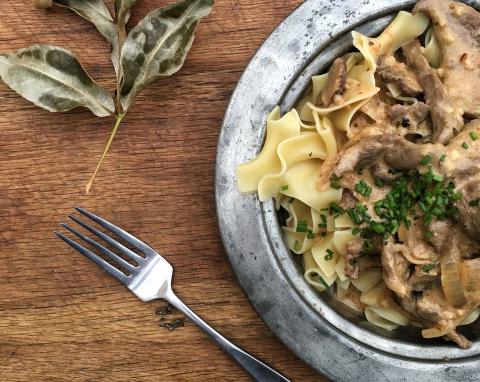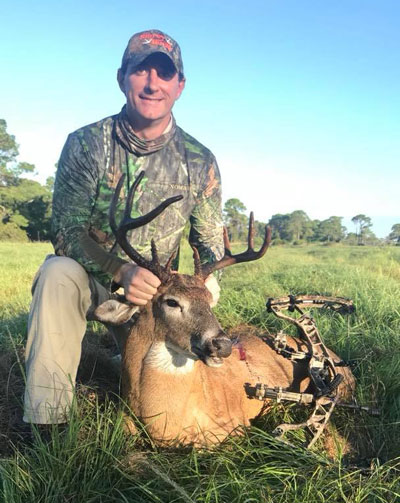 Mossy Oak ProStaffer Brandon Storey of Okeechobee, Florida, is the owner of Storey Hunts and lives in the center of, according to him, “Everything that’s fun to do.” He is an hour from Disney World, one hour from the beach, in the center of the finest big bass and crappie fishing and right in the middle of some of the best hunting in the world. So, while Dad’s hunting or fishing, Mom and the kids can enjoy the beach or Disney World. Does life get any better than this?
Mossy Oak ProStaffer Brandon Storey of Okeechobee, Florida, is the owner of Storey Hunts and lives in the center of, according to him, “Everything that’s fun to do.” He is an hour from Disney World, one hour from the beach, in the center of the finest big bass and crappie fishing and right in the middle of some of the best hunting in the world. So, while Dad’s hunting or fishing, Mom and the kids can enjoy the beach or Disney World. Does life get any better than this?
Storey Hunts offers free-range, white-tailed deer hunts, Osceola turkey hunts, wild hog hunts, a high-fence ranch for hunting exotics like red stag, axis, fallow, sika and black bucks, alligator hunting, big bass fishing on Lake Okeechobee and some of the finest crappie fishing you’ll find anywhere. If someone wants to hunt or fish, he or she can come and hunt or fish here at almost any time of the year. Storey Hunts has 30,000 acres where we can deer and turkey hunt here in the South Zone of Florida. We hunt the Seminole white-tailed deer that thrive in the south Florida heat and can endure the parasites found here. We hunt oak hammocks, marshes and palmetto swamps for the Seminole deer that can survive in these extremely hot temperatures here in south Florida, just like the deer in Canada survive in those very cold temperatures. These Seminole deer live in a range from just above the Keys up to about Orlando. Once you get into north Florida, you’ll find the Panhandle deer. Most of the Seminole deer will weigh from 150-200 pounds, and we may harvest a few that weigh over 200 pounds.
Our Seminole deer that are 5-1/2 years old will have racks of 120 to 140 inches. Most of the Seminole deer will score 120-125 inches. But this area is raising more Seminole deer that will score 130-140 inches, since we’ve been supplemental feeding high-protein pellets year round and planting numbers of green fields. The soil in this section of Florida has a lot of salt, so the one thing our deer are lacking is protein. That’s why we’ve been feeding protein to increase the sizes and weights of our bucks and their antler sizes. The average deer in this region on public lands in south Florida will weigh 20-30 pounds less than the deer on our private lands do, and their racks will be 10-20 inches smaller.
The bow season in the South Zone of Florida starts the last weekend in July. Everything north of Highway 70 is considered Florida’s Central Zone. Storey Hunts is located in the middle of both zones. In the Central Zone, our bow season begins September 15. So, bowhunters who want to get a head start on deer or big game hunting with their bows can come here to south Florida and take deer before most states open up bowhunting for deer.
The buck deer in the Everglades start rutting during the last of July and the first of August. The bucks in the Central Zone, only an hour away, begin rutting at the end of August and the first of September. Our deer season in this section of Florida doesn’t usually end until the first of January. So, our region of Florida has about six months of breeding season. We have hunters come in around the first of August and have hunters deer hunting with us until the first of January.
Deer and Wild Hogs on Same Hunt
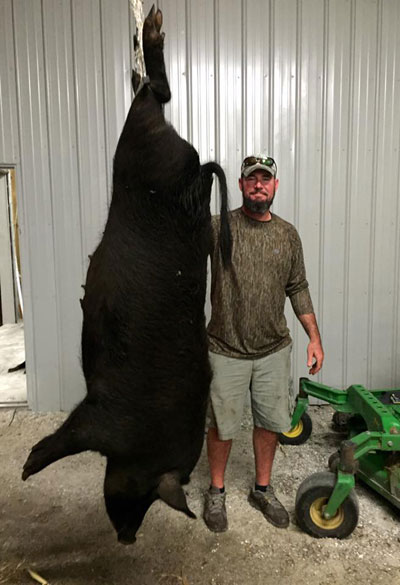 At most hunting operations, when a hunter bags a buck deer, his hunt is over. But here in Florida where we hunt, once a hunter bags a buck, he can shoot wild hogs or go bass fishing or crappie fishing here at Lake Okeechobee. Most of our hunters hunt in the afternoon, a time when the deer are moving. What some of our hunters prefer to do is bass or crappie fish in the mornings, come in, eat lunch, take a nap and then hunt deer in the afternoons. My best buck taken here in our area was 142 inches. We had hunters last year harvest bucks 134-135 inches. We’ve really been feeding lots of protein to our deer for the past 5 years, and we’ve seen bigger racks and better body weights all across south Florida. More ranchers in south Florida are now feeding protein to their whitetails than ever before, and they’re seeing the results they’d hoped to get with bigger bucks.
At most hunting operations, when a hunter bags a buck deer, his hunt is over. But here in Florida where we hunt, once a hunter bags a buck, he can shoot wild hogs or go bass fishing or crappie fishing here at Lake Okeechobee. Most of our hunters hunt in the afternoon, a time when the deer are moving. What some of our hunters prefer to do is bass or crappie fish in the mornings, come in, eat lunch, take a nap and then hunt deer in the afternoons. My best buck taken here in our area was 142 inches. We had hunters last year harvest bucks 134-135 inches. We’ve really been feeding lots of protein to our deer for the past 5 years, and we’ve seen bigger racks and better body weights all across south Florida. More ranchers in south Florida are now feeding protein to their whitetails than ever before, and they’re seeing the results they’d hoped to get with bigger bucks.
We feed 20-percent protein all year and then feed 25-percent protein as we move into the summer when the deer are growing their antlers and putting on more body weight. Our feed also has some citrus pulp in it. South Florida deer really like to eat citrus. One of the other feeds we use is just citrus pulp. It doesn’t have much protein in it, but the citrus pulp comes from when companies smash the citrus, get the juice out, dry the rinds, compress them and make them into pellets. This citrus pulp is one of the best deer attractants in south Florida.
We only take about 10 white-tailed hunters each year on our hunts. I try not to overbook because each of our hunters hunts with me, and we’re hunting individual bucks on the ranches we have. I find the bucks and pattern them. We run trail cameras and make a hit list of the bucks we feel are old enough to harvest. We have numbers of great-looking young bucks that most anyone will want to shoot. However, we want to make sure to try and take the oldest bucks on each ranch we hunt. That’s why we target particular bucks to hunt and take on each ranch.
The good thing about our wild hog hunts is that hunters can take hogs all year. A good number of our hog hunters come here in the cooler months when the weather’s not so hot. However, many people also come down here in the summer months to harvest wild hogs to gear up for deer season and big-game seasons in other states. Most of the time our hunters prefer to take wild hogs weighing 100-150 pounds each that we classify as meat hogs. But some hunters want to hunt trophy wild hogs that weigh 200-350 pounds and generally have 3-inch-long teeth.
We’ll set up trail cameras and do a lot of glassing. We get some citrus peelings before they’re dried and smashed into pellets and put those out to bait up the wild hogs. We also have corn feeders, oak trees dropping acorns and citrus fields and know that’s where the meat hogs and the trophy hogs will be. The wild hogs usually come out of the wetlands to the food sources, which is where we set up the hunters.
I’m often asked what we do about human odor and mosquitoes in our hot weather. We use a wide variety of odor-killing products and usually two Thermacells at each stand. The Thermacells work much better than any other type of insect repellant. Too, we’ve never had any negative reactions to the Thermacells from our hog or deer hunters.
Hunts for Osceola Turkeys and Alligators, Fishing for Crappie and Bass and Visiting Nearby Beaches
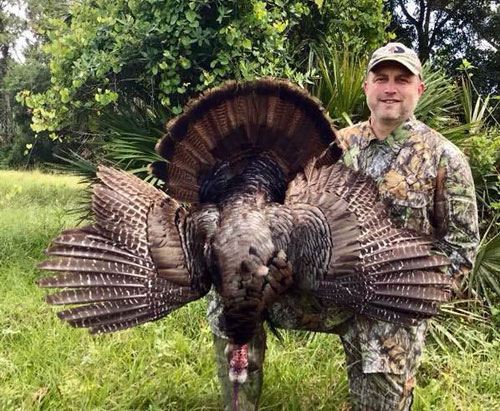 Because we hunt the Osceola turkey where we live, and that particular turkey has a very limited scope in Florida, we have numbers of hunters who come to hunt these birds. Most of those hunters do a combo trip of hunting turkeys and fishing for largemouth bass and/or crappie. I have some guides who guide turkey hunters for me who also have their captains’ licenses and guide fishermen on Lake Okeechobee.
Because we hunt the Osceola turkey where we live, and that particular turkey has a very limited scope in Florida, we have numbers of hunters who come to hunt these birds. Most of those hunters do a combo trip of hunting turkeys and fishing for largemouth bass and/or crappie. I have some guides who guide turkey hunters for me who also have their captains’ licenses and guide fishermen on Lake Okeechobee.
Our turkey hunts begin the first of March – one of the earliest turkey seasons in the nation. Our ranch is both in Florida’s South Zone and the Central Zone. The South Zone opens the first of March for turkeys, and the Central Zone opens the third week of March. I’m often asked how early someone has to book a turkey hunt with us. I book a year in advance for turkey hunts. Right now I’m already booked for 2019 turkey season. We hunt about 25-30 Osceola hunters each year. Our ranch property homes numbers of Osceola turkeys, but we only harvest about one-fourth of the gobblers we could harvest. If one of private ranches has 20 mature Osceola gobblers on it, we’ll only take five gobblers off that ranch. We’ve had 100-percent hunter shot opportunities for 11 years, which is due to our under-harvesting turkeys on all the properties we hunt.
One of our biggest attractions is the beaches in our section of Florida. You can drive one hour from our camp and be on the beach at the Gulf of Mexico if you go west or on the Atlantic Ocean beaches if you drive east. We’re also 1-1/2 hours from Disney World. So, many of our hunters will bring their families with them, and their families can enjoy the beaches and/or going to Disney World, while the dads hunt and/or fish.
Another hunting opportunity that we have on our ranches is alligator hunting that starts at the end of August and continues through the end of October. Our section of Florida has had a very good gator season this year in 2018 – taking numbers of 9-12 foot alligators. Although Storey Hunts does some crossbow hunting for alligators, we do more hook and line hunting for alligators. We like to hook and line hunt for alligators. Then if we catch a gator that’s not the size our hunter wants, we can cut the line and release the gator. Once our hunter gets the alligator hooked on a treble hook, the hunter can shoot the gator with his crossbow and run down the gator and harpoon it. Or, you can pull the gator up beside the boat and take it with a bang stick (also known as a powerhead, a smokie or a shark stick that’s a specialized firearm used underwater that’s fired when in direct contact with the alligator).
Chicken on a Stick for Taking Alligators
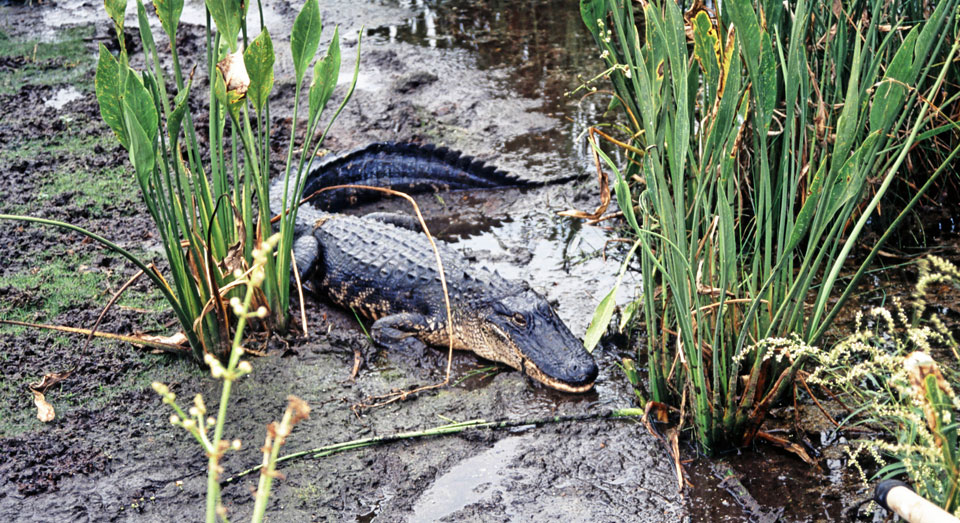
One of the new ways we’ve been catching alligators is called the chicken-on-a-stick technique. We take a dead guinea hen, let it rot for a day or two and then impale it on a part of a wooden broom handle. We’ll put the other end of the broom handle in the mud on the bank and have a rope tied to that broom handle. When the gator comes up and eats the chicken that’s on part of the broom handle, it will swallow the chicken and the segment of the broom handle where the chicken has been. Then when we come to catch the gator, we can pull on the rope, the gator will keep its mouth shut, and we can pull the gator up alongside the boat and take the gator.
We also may throw the chicken on the stick into the weeds, because the older, smarter gators will have wised-up to being taken with a bow or a harpoon. So, in the later part of the season, we still take some big gators by using the chicken-on-a-stick trick. Generally we can attach a heavy saltwater rod and reel to the line that goes to the live alligator. Then the gator hunter can fight that gator for an hour or two with the big, deep-sea-fishing rod before getting the alligator up to the boat and taking it with a bang stick.
Once the hunter finally dispatches the gator with the bang stick, then that’s his gator. He can eat the gator, tan its hide and make boots, suitcases and/or belts out of the hide or put it on ice to take home and show his friends. After the gator’s in the boat, the gator goes to the processor. Then the hunter decides if he wants to keep the meat, keep the hide, mount the gator or sell the gator to the processor and go home with some money and the memory of an exciting hunt. Alligator hunts run from mid-August until the end of October.
Live Shiners for 8-12 Pound Bass and Live Minnows for 100 Crappie at Storey Hunts
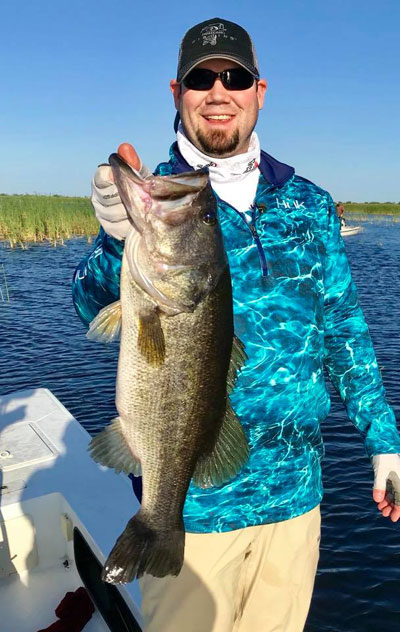 I only have about 2 months off during the year when we’re not doing something at Storey Hunts. So, as soon as turkey season ends, I flat fish on both the east and west coasts of Florida, but primarily on the west coast (Gulf of Mexico). Since our deer season starts at the end of July, I don’t have but a few months off. Before the season, I start feeding protein to the deer and work on our green fields where we plant aeschynomene, a flowering legume that grows well in south Florida’s sandy, acidic soil and hot weather, and clover. When we move closer to the winter, we then put out rye, wheat and oats. The more the deer eat of the aeschynomene, the more it grows. We mix Ladino clover and Alice clover with the aeschynomene.
I only have about 2 months off during the year when we’re not doing something at Storey Hunts. So, as soon as turkey season ends, I flat fish on both the east and west coasts of Florida, but primarily on the west coast (Gulf of Mexico). Since our deer season starts at the end of July, I don’t have but a few months off. Before the season, I start feeding protein to the deer and work on our green fields where we plant aeschynomene, a flowering legume that grows well in south Florida’s sandy, acidic soil and hot weather, and clover. When we move closer to the winter, we then put out rye, wheat and oats. The more the deer eat of the aeschynomene, the more it grows. We mix Ladino clover and Alice clover with the aeschynomene.
In the summer months, our fishing picks up, and we’re catching 2-4 pound largemouth bass, primarily on artificial lures, generally top-water ones, along the edges of weed lines at first light. Next we flip and pitch plastic worms into the grass when the sun gets up. In the fall, we fish with live golden river shiners and catch big bass, 8-12 pounders, almost every day. We’ll still be catching 2-4 pounders. You can take a couple of dozen live shiners with you, fish along the weedlines and come in with some nice big bass at the end of the day.
Lake Okeechobee also homes great crappie fishing. My dad’s really big into fishing for crappie with jigs. Our best crappie fishing begins in October and is very good from November through January. Some of the same guides who guide for bass fishing also guide for crappie fishing. In a 4-hour jig fishing trip during the fall and winter, you’ll catch 20-40 crappie. If you’re fishing with live minnows, we’ve had anglers catch and release 100 crappie in four hours. The limit on crappie you can keep is 25 per person, but of course, you can catch and release them until you get tired of fishing.
















